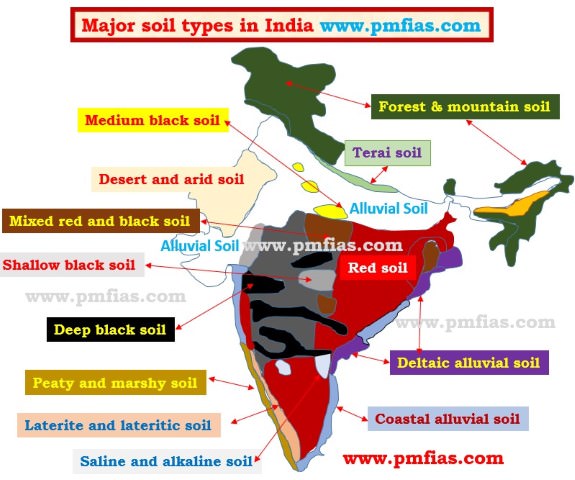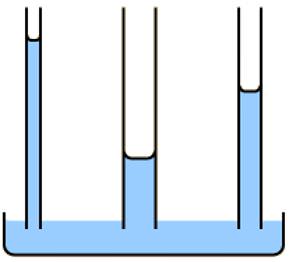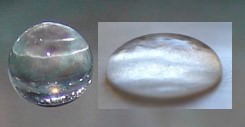Major Soil Types of India: Red Soils, Lateritic Soils & Alkaline Soils
Table of Contents

Red Soils
- Red soils along with its minor groups form the largest soil group of India.
- The main parent rocks are crystalline and metamorphic rocks like acid granites, gneisses and quartzites.
Characteristics of Red Soils
- The texture of these soils can vary from sand to clay, the majority being loams.
- On the uplands, the red soils are poor, gravelly, and porous. But in the lower areas they are rich, deep dark and fertile.
Chemical Composition of Red Soils
- They are acidic mainly due to the nature of the parent rocks. The alkali content is fair.
- They are poor in lime, magnesia, phosphates, nitrogen and humus.
- They are fairly rich in potash and potassium.
Color of Red Soils
- The red colour is due to the presence of iron oxide.
- When limestone, granites, gneisses and quartzites are eroded the clay enclosed within the rocks remains intact with other forms of non-soluble materials.
- In oxidizing conditions, rust or iron oxide develops in the clay, when the soil is present above the water table giving the soil a characteristic red colour.
- The colour is more due to the wide diffusion rather than high percentage of iron oxide content.
Distribution of Red Soils
- These soils mostly occur in the regions of low rainfall.
- They occupy about 3.5 lakh sq km (10.6 per cent) of the total area of the country.
- These soils are spread on almost the whole of Tamil Nadu.
- Other regions with red soil include parts of Karnataka, south-east of Maharashtra, Telangana, Andhra Pradesh, Madhya Pradesh, Chhattisgarh, Odisha, Chota Nagpur plateau; parts of south Bihar, West Bengal, Uttar Pradesh; Aravalis and the eastern half of Rajasthan (Mewar or Marwar Plateau), parts of North-Eastern states.
Crops in Red Soils
- The red soils are mostly loamy and hence cannot retain water like the black soils.
- The red soils, with the proper use of fertilizers and irrigation techniques, give good yield of cotton, wheat, rice, pulses, millets, tobacco, oil seeds, potatoes and fruits.
Laterite – Lateritic Soils
- Laterite soils are mostly the end products of weathering.
- They are formed under conditions of high temperature and heavy rainfall with alternate wet and dry periods.
- Heavy rainfall promotes leaching (nutrients gets washed away by water) of soil whereby lime and silica are leached away and a soil rich in oxides of iron and aluminium compounds is left behind.
- ‘Laterite’ means brick in Latin. They harden greatly on loosing moisture.
- Laterite soils are red in colour due to little clay and more gravel of red sand-stones.
Chemical composition of Laterite – Lateritic Soils
- Laterite soils are rich in bauxite or ferric oxides.
- They are very poor in lime, magnesia, potash and nitrogen.
- Sometimes, the phosphate content may be high in the form of iron phosphate.
- In wetter places, there may be higher content of humus.
Distribution of Laterite – Lateritic Soils
- Laterite soils cover an area of 2.48 lakh sq km.
- Continuous stretch of laterite soil is found on the summits of Western Ghats at 1000 to 1500 m above mean sea level, Eastern Ghats, the Rajmahal Hills, Vindhyan, Satpuras and Malwa Plateau.
- They also occur at lower levels and in valleys in several other parts of the country.
- They are well developed in south Maharashtra, parts of Karnataka etc. and are widely scattered in other regions.
Crops in Laterite – Lateritic Soils
- Laterite soils lack fertility due to intensive leaching.
- When manured and irrigated, some laterites are suitable for growing plantation crops like tea, coffee, rubber, cinchona, coconut, arecanut, etc.
- In some areas, these soils support grazing grounds and scrub forests.
Economic value of Laterite – Lateritic Soils
- Laterite and lateritic soils provide valuable building material.
- These soils can be easily cut into cakes but hardens like iron when exposed to air.
- As it is the end-product of weathering, it cannot be weathered much further and is durable.
Forest – Mountain Soils
- These soils occupy about 2.85 lakh sq km or 8.67% of the total land area of India.
- They are mainly heterogeneous soils found on the hill slopes covered by forests.
- The formation of these soils is mainly governed by the characteristic deposition of organic matter derived from forests and their character changes with parent rocks, ground-configuration and climate.
- Consequently, they differ greatly even if they occur in close proximity to one another.
Distribution of Forest – Mountain Soils
- In the Himalayan region, such soils are mainly found in valleys, less steep and north facing slopes. The south facing slopes are very steep and exposed to denudation and hence do not support soil formation.
- Forest soils occur in Western and Eastern Ghats also.
Chemical properties of Forest – Mountain Soils
- The forest soils are very rich in humus.
- They are deficient in potash, phosphorus and lime.
- They require good deal of fertilizers for high yields.
Crops in Forest – Mountain Soils
- They are suitable for plantations of tea, coffee, spices and tropical fruits in peninsular forest region.
- Wheat, maize, barley and temperate fruits are grown in the Himalayan forest region.
Arid – Desert Soils
- The desert soils consist of Aeolian sand (90 to 95 per cent) and clay (5 to 10 per cent).
- They cover a total area of 1.42 lakh sq km (4.32%).
- The presence of sand inhibits soil growth. Desertification of neighboring soils is common due to intrusion of desert sand under the influence of wind [Aeolian sand].
Distribution of Arid – Desert Soils
- Occur in arid and semi-arid regions of Rajasthan, Punjab and Haryana. The sand here is blown from the Indus basin and the coast by the prevailing south-west monsoon winds.
- Sandy soils without clay factor are also common in coastal regions of Odisha, Tamil Nadu and Kerala.
Chemical properties of Arid – Desert Soils
- They are usually poor in organic matter.
- Some desert soils are alkaline with varying degree of soluble salts like calcium carbonate.
- Calcium content increases downwards and the subsoil has ten times more calcium.
- The phosphate content of these soils is as high as in normal alluvial soils.
- Nitrogen is originally low but some of it is available in the form of nitrates.
Crops of Arid – Desert Soils
- Phosphates and nitrates make these soil fertile wherever moisture is available.
- There is a possibility of reclaiming these soils if proper irrigation facilities are available.
- In large areas, only the drought resistant and salt tolerant crops such as barley, cotton, millets, maize and pulses are grown.
Saline – Alkaline Soils
- In Saline and Alkaline Soils, the top soil is impregnated (soak or saturate with a substance) with saline and alkaline efflorescences (become covered with salt particles).
- Undecomposed rock fragments, on weathering, give rise to sodium, magnesium and calcium salts and sulphurous acid.
- Some of the salts are transported in solution by the rivers.
- In regions with low water table, the salts percolate into sub soil and in regions with good drainage, the salts are wasted away by flowing water.
- But in places where the drainage system is poor, the water with high salt concentration becomes stagnant and deposits all the salts in the top soil once the water evaporates.
- In regions with high sub-soil water table, injurious salts are transferred from below by the capillary action as a result of evaporation in dry season.
Capillary action
 Surface tension
 What gives water droplet its shape?
 |
Distribution of Saline – Alkaline Soils
- Saline and Alkaline Soils occupy 68,000 sq km of area.
- These soils are found in canal irrigated areas and in areas of high sub-soil water table.
- Parts of Andhra Pradesh, Telangana, Karnataka, Bihar, Uttar Pradesh, Haryana, Punjab (side effects of improper or excess irrigation), Rajasthan and Maharashtra have this kind of soils.
- The accumulation of these salts makes the soil infertile and renders it unfit for agriculture.
- In Gujarat, the areas around the Gulf of Khambhat are affected by the sea tides carrying salt-laden deposits. Vast areas comprising the estuaries of the Narmada, the Tapi, the Mahi and the Sabarmati have thus become infertile.
- Along the coastline, saline sea waters infiltrate into coastal regions during storm surges (when cyclones make landfall) and makes the soil unfit for cultivation. The low lying regions of coastal Andhra Pradesh and Tamil Nadu face this kind of soil degradation.
Peaty – Marshy Soils
- These are soils with large amount of organic matter and considerable amount of soluble salts.
- The most humid regions have this type of soil.
- They are black, heavy and highly acidic.
Distribution of Peaty – Marshy Soils
- Kottayam and Alappuzha districts of Kerala where it is called kari.
- Also occur in the coastal areas of Odisha and Tamil Nadu, Sunderbans of West Bengal, in Bihar and Almora district of Uttarakhand.
Chemical Properties of Peaty – Marshy Soils
- They are deficient in potash and phosphate.
Crops of Peaty – Marshy Soils
- Most of the peaty soils are under water during the rainy season but as soon the rains cease, they are put under paddy cultivation.
Characteristics of Indian Soils
- Most soils are old and mature. Soils of the peninsular plateau are much older than the soils of the great northern plain.
- Indian soils are largely deficient in nitrogen, mineral salts, humus and other organic materials.
- Plains and valleys have thick layers of soils while hilly and plateau areas depict thin soil cover.
- Some soils like alluvial and black soils are fertile while some other soils such as laterite, desert and alkaline soils lack in fertility and do not yield good harvest.
- Indian soils have been used for cultivation for hundreds of years and have lost much of their fertility.
Problems Of Indian Soils
- Soil erosion (Himalayan region, Chambal Ravines etc.), deficiency in fertility (Red, lateritic and other soils), desertification (around Thar desert, rain-shadow regions like parts of Karnataka, Telangana etc.), waterlogging (Punjab-Haryana plain) salinity and alkalinity (excessively irrigated regions of Punjab, Haryana, Karnataka etc.), wasteland, over exploitation of soils due to increase in population and rise in living standards and encroachment of agricultural land due to urban and transport development
.